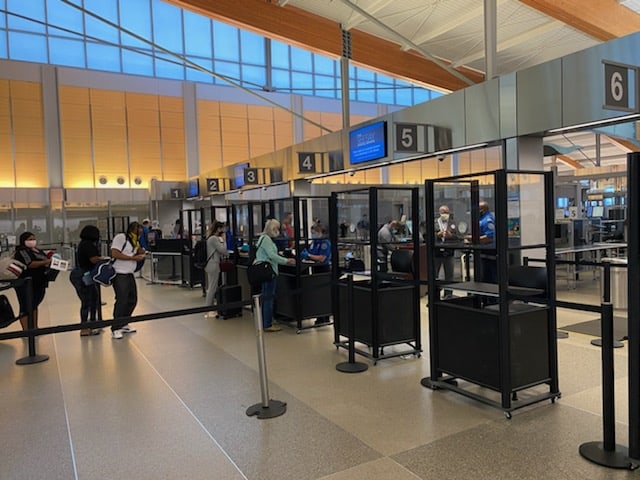Article, FEATURED STORIES, U.S.
Trans Teen Suing TSA After Being Told To Expose Genitals

Kimberly Erway, the mother of the trans teen allegedly told to expose her genitals before boarding a 2019 flight, is now suing the Transportation Security Administration (TSA) in a filed 11-page complaint to the U.S. District Court for the Eastern District of North Carolina. Jamii Erway, who was 15 years old at the time of the incident, was on her way to board a flight from North Carolina to Rochester, New York.
The lawsuit follows an ongoing conversation about the anxiety that transgender travelers face at airports.
TSA SCREENING PROCEDURES FOR TRANS PASSENGERS: WHAT IS A ‘FALSE POSITIVE’?
Traveling passengers must undergo a security search at TSA checkpoints through a body scanning device called Advanced Imaging Technology (AIT). These scanners, equipped with software called Automatic Target Recognition (ATR), scans an outline of the body based on whether the passenger presents themselves as “male” or “female.”
However, for transgender passengers, ATRs have proven to cause unfortunate problems. An alarm goes off on the scanner if an ‘anomaly,’ or an outlined area not typical of a person’s gender, is identified. This “false-positive” causes suspicion of possessing a threat item such as a bomb.
So, if a trans woman with external genitalia enters the body scanner as a female, an anomaly in the groin area is flagged. In other words, TSA software is exclusive and does not account for trans and intersex bodies. These “areas of the body warranting further inspection,” or anomalies, sadly happen to transgender passengers more often than not. This is what Erway often deals with when traveling.
ERWAY V. UNITED STATES TSA AND JANE DOE
TSA encounters like these are common for Erway who, while going through the scanner, set off a “false-positive” on her groin area. Erway informed the operator that she was transgender and asked to be re-scanned by “pressing the other button.” However, the body scanner operator declined the request.
The operator called over the supervisor, whom, in the suit, is referred to as Jane Doe. After being made aware of the situation, Doe told Erway that she would need to accompany her to a private room and allow Doe to “feel up in there.” Despite Erway’s protest against the inappropriate search, Doe said that Erway would not be allowed to leave until she complied with the search.
Kimberly, Erway’s mother, was allegedly told to “mind her business” before being demanded to force Erway to comply with the strip search. When Kimberly refused, Doe then called a police officer who said he would not assist in detaining the teen.
TSA procedure for resolving a body screening alarm is for a TSA officer to conduct further inspection of a possible threat through a pat-down procedure. Doe did not provide nor suggest a pat-down search. Doe’s failure to do so was unlawful and discriminatory, especially to a minor. Her actions do not comply with TSA procedures which the suit claims “explicitly prohibits checkpoint screeners (including all levels of supervisors) from conducting strip searches and from making direct contact with the genitals of travelers.”
According to the lawsuit, the Erways “left the airport, rented a car, and drove over 600 miles to return home.”
TRAVELING WHILE TRANSGENDER
Doe’s actions have allegedly caused Erway to experience “severe emotional distress, including symptoms of panic, anxiety, fear, racing heart, shortness of breath, uncontrollable shaking, and nausea.”
Erway has every right to feel this way. The humiliating experience is, unfortunately, common for traveling trans people. The mistreatment of trans passengers has been an ongoing issue for the TSA for so long that traumatizing encounters with TSA are shared using the hashtag #TravelingWhileTrans.
A 2015 U.S. Trans Survey found that “Forty-three percent (43%) of those who went through airport security in [2014] experienced at least one issue related to their gender identity or expression, such as TSA officers using the wrong pronoun or title to refer to them, searching their bodies or belongings because of a gender-related item, or detaining them.”
Just last year, Rosalynne Montoya, a non-binary transgender, Hispanic, bisexual, model, and activist, sparked another conversation after they shared their negative experiences on TikTok of going through airport security, claiming they always get “immense anxiety.”
Montoya, like Erway, says they usually set off the body scanners because of their body. For Montoya, going through the “female” scanner triggers the alarm because of the “‘anomaly’ between my legs.” Using the “male” scanner triggers the alarm because they have breasts. Following both alarms, Montoya said, “She (the TSA officer) was like, ‘OK, well we have to pat you down. Do you want a man to do it?’ I said, ‘NO! Absolutely not.’”
In a follow-up video, Montoya explains how TSA can do better, saying that the problem within the TSA security system is systemic transphobia.
“TSA needs to remove the gendered settings from their scanners,” they said, “And they should believe me when I tell them that I’m a trans woman and that I don’t wanna be pat-down by a man or scanned as a man because I’m not one.”
Montoya continues to use her platform to expose transphobia in a system of power. “The root solution is simple,” they said, “Believe transgender people when we tell you who we are.”
As for Erway, she now seeks $1,000,000 in alleged damages. If you are transgender and weary or uncertain of traveling, please visit The National Center for Transgender Equality, which offers a “Know Your Rights” guide on airports.

